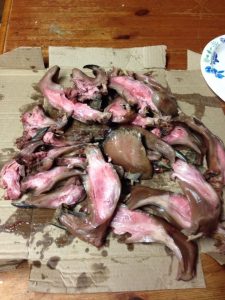I never liked Ikea.
The stuff looks great in the showroom but is a pain to assemble and never quite looks the same.
 IKEA is opening a “Do-It-Yourself Restaurant”, in which diners will be the chefs. Anyone attending IKEA’s ‘Dining Club’ will be able to cook a meal for up to 19 pals under the supervision of a head chef.
IKEA is opening a “Do-It-Yourself Restaurant”, in which diners will be the chefs. Anyone attending IKEA’s ‘Dining Club’ will be able to cook a meal for up to 19 pals under the supervision of a head chef.
According to an Ikea statement, “diners will orchestrate an intimate foodie experience in a homely kitchen environment to mimic an actual dinner party, but one where diners can host many more guests than usual.”
No mention of liability.
I don’t want a do-it-yourselfer who only knows about food safety from cooking shows – fail – preparing meals for anyone.
We’re gearing up to host Canadian Thanksgiving for a few dozen people at a park so the kids can run around and the parents can chill. I cook the bird. I’ll transport it safely and I’ll serve it safely. Who knows what other microorganisms the others will bring.
Danielle Bowling of Hospitality Magazine writes that Australia has welcomed a new food delivery service, FoodByUs, where home cooks – not chefs – are the ones preparing meals.
After receiving a $2 million investment, the concept launched in late August and is the brainchild of Ben Lipschitz, Menulog co-founder Gary Munitz and Tim Chandler, ex-Menulog lead developer.
 FoodByUs allows consumers to order meals or snacks prepared by home cooks, and either pick it up from their house, or have it delivered for an additional $5.
FoodByUs allows consumers to order meals or snacks prepared by home cooks, and either pick it up from their house, or have it delivered for an additional $5.
Lipschitz said consumers need not be concerned about the fact that the meals aren’t prepared in a commercial kitchen.
“Food safety is taken very seriously at FoodByUs. There’s absolutely nothing illegal about selling food that’s made from your home. It’s very clearly regulated by councils and at times, state government. So we make sure that the cooks are compliant and we help them in understanding those processes,” he told Hospitality.
Pinto defense: we meet all government standards. Flashing red light warning.
Depending on the food being prepared, local councils may or may not inspect the cook’s kitchen, Lipschitz said, and FoodByUs – which has recruited 80-odd cooks, including ex-chefs and MasterChef contestants – doesn’t require food to be prepared in its test kitchen before making it available to consumers.
Ex-chefs and MasterChef contestants know shit about food safety in Australia (see any of the post entitled, Australia still has an egg problem).
“There’s no need to watch them prepare it, and in fact the requirement in terms of their premises always falls back on the council, so from our perspective there would be no point having them prepare it in our kitchen.
“The application process simply involves the cook bringing their food into a tasting centre and allowing us to do a quality and taste test. At that point we also take identification so there’s accountability and then they’re able to sell food on the network. The third thing we do is that every single buyer must review their purchase; they actually can’t continue using the service or app until they’ve reviewed their purchase. That means that we’ve got live, up-to-date feedback,” he said.
Maybe they have those groovy bacteria-sensing goggles.
From the advert:
Experience
Not Applicable
Job description
Cook, bake and create family meals in your area – flexible hours, great income
Earn over $500 / week, reaching thousands of buyers
Create Your Own Products, Schedule & Pricing
Free to Join, No Contracts
https://www.foodbyus.com.au/maker-registration/
Are you a quality cook looking for additional income? Turn your kitchen (home or commercial) into dollars by selling food to a huge community of hungry local buyers looking for quality meals to feed their families. FoodByUs (www.foodbyus.com.au) is actively looking for passionate cooks to make authentic food. Aussie favourites, food from back home and food specially crafted for different dietary requirements are all welcome. Our part-time food makers earn over $500 / week and it’s free to join.
FoodByUs.com.au allows cooks to sell quality food online. No one who sells food on our site is a restaurant or big producer – rather we enable passionate cooks who make food from home or a commercial kitchen to independently sell their own food! You can make anything from delicious lunches and dinners through to sauces, cakes, cookies, pies or even empanadas if you like. Create your own products, your own cooking schedule and your own prices. We have appeared on national media like The Today Show, Channel 10, news.com.au, Grazia and more – we’re well known and ready to get you customers.
Not a mention of food safety.
Lawyers, sharpen your pencils.
 Rigby has just released the latest annual Sydney Morning Herald Good Food Guide and said while the food industry was going strong, many restaurants were still having a tough time finding staff.
Rigby has just released the latest annual Sydney Morning Herald Good Food Guide and said while the food industry was going strong, many restaurants were still having a tough time finding staff.











